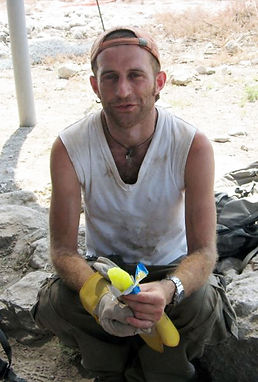Doron Boness
Ph.D. candidate

© BGU Microarchaeology all rights reserved
Doron Boness completed in 1999 a BSF in photography at the School of Visual Arts, New York. In 2007-9 he took completion studies in archaeology at the Department of Archaeology and Ancient Near Eastern Cultures, Tel Aviv University. In 2012 he completed an M.A. (summa cum laude) in Archaeology and Archaeomaterials under the supervision of Prof. Yuval Goren (then at Tel Aviv University) and Prof. A. Nigel Goring-Morris (The Hebrew University in Jerusalem). The topic of the thesis was: A Micromorphological Study of Sediments from Southern Levantine PPNB Sites: Identifying Activities and their Spatial Distribution within the Sites, and Possible Implications on Social Structure. Since 2013 he is a Ph.D. candidate. His dissertation is entitled: Aspects of Everyday Life and Death at the Rural Minoan site of Koumasa, Crete: A Microarchaeological Study.
The Ph.D. research is a michroacrhaeological study of sediments, construction materials and artifacts at the Minoan site at Koumasa, Crete. This rural site is situated on the northern fringes of the Asterousia Mountains in southern Crete, overlooking the Mesara plain, and encompasses the entire Bronze-Age Minoan cultural period. The site consists of three occupation areas: a settlement, a precinct whose nature is still unclear, and a tholos cemetery. The site was first excavated at the beginning of the 20th century, but renewed excavations at the site began in 2012 and a few additional seasons are planned.The main research methods employed will be micromophology, a method based on optical mineralogy, in conjunction with complementary methods, mainly, but not exclusively, XRF. The aim of this proposed study is twofold: first, to provide new insights into the history of a rural regional center, encompassing all aspects of everyday life, including subsistence and household economy, industry and commerce, social organization, as well as ideology expressed in everyday ritual and in mortuary practices. Second, for the first time, micromorphology and other complementary methods will be applied systematically at a single Minoan site, following well-defined research questions. This fine-grained study of the settlement occupation area will contribute to the understanding of the Minoan household at a rural settlement, by producing a high-resolution picture of practices and their spatial organization, as well as of domestic economy. This research would thus provide much-needed new insights into Minoan archaeology, counter-balancing traditional historical narratives centering on the palatial centers. The study of ceramics and construction materials may shed light on production/consumption patterns, as well as on local social, economic, and perhaps, ideological adaptation in technology.
Publications
-
Malinsky-Buller, A., Aldajem, E., Givol-Barzilai, Y., Boness, D., Goren, Y., Yeshurun, R. and Birkenfeld, M. 2013. Another Piece in the Puzzle – a New PPNA Site at Bir-el-Maksur (Northern Israel). Paleoriént 39(2): 155-172.
-
Bocquentin, F., Khalaily, H., Bar-Yosef Mayer, D.E., Berna, F., Bitton, R., Boness, D., Dubreuil, L., Emery-Barbier, A., Greenberg, H., Goren, Y., Horwitz, L.K., Le Dosseur, G., Lernau, O., Mienis, H.K., Valentin, B., Samuelian, N. 2014. Renewed Excavations at Beisamoun: Investigating the VIITH Millennium Cal. BC of the South Levant. Journal of The Israel Prehistoric Society 44: 5-100.
-
Boness, D., Clark, J. and Goren, Y. 2015. Ceramic Neolithic Pottery in Cyprus – origin, technology and possible implications for social structure and identity, a Petrographic Study. Levant 47/3: 233-254.
-
Boness, D., Sheftelowitz, N., Fabian, P., Gilead, I. and Goren, Y. 2016. Petrographic Study of the Pottery Assemblages from Horvat Qarqar South, a Ghassulian Chalcolithic cemetery in the Southern Levant. Bulletin of the American Schools of Oriental Research 375: 191-219.
-
Boness, D., Panagiotopoulos, D. and Goren, Y. Early Minoan Mortuary Practices as Evident by Microarchaeological Studies at Koumasa, Crete. Journal of Archaeological Science: Reports 11: 507–522.
-
Boness, D., Panagiotopoulos, D. and Goren, Y. A Minoan Plaster Technology as Evident from the ‘Precinct’ Structure at Koumasa, Crete: A Microarchaeological Study. Journal of Archaeological Science: Reports 14: 392-408.
-
Boness, D. and Goren, Y. In Press. Petrographic Study of the Iron Age and Persian Period at Ramat Rahel.
Conferences and Workshops
-
2015, The Ghassulian Technology: Social and Cultural aspects. 8th Meeting. The Chalcolithic Research Forum. Origin and Technology of the Pottery Assemblages from Horvat Qarqar South: a Petrographic Study (in Hebrew).
-
2012, Opportunities, Problems and Future Directions in the Research of Middle Paleolithic Open-Air Sites,Tel Hai College, Israel. Ein Qashish – A Late Middle-Palaeolithic Site: A Micromorphological Study.
-
2011, Microarchaeology Workshop, Kimmel Center for Archaeological Science,
-
Weizmann Institute of Science in Rehovot, Israel. Neolithic Pottery in Cyprus – Origin, Technology and Possible Implications on Social Structure and Identity: A Petrographic Study.
-
2010, International Congress of Archaeological Sciences in Eastern Mediterranean and Near East (ICASEMNE), The Cyprus Institute in Paphos, Cyprus. Neolithic Pottery in Cyprus – Origin, Technology and Possible Implications on Social Structure and Identity: A Petrographic Study.





